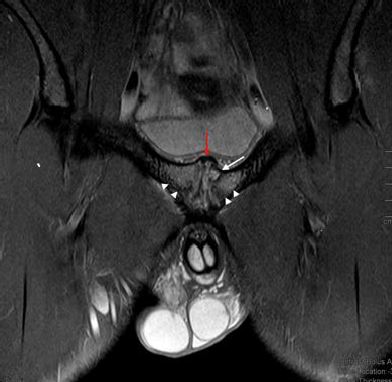Hallazgos en RM pubiana y de caderas en jugadores profesionales de fútbol
Palabras clave:
RM pubiana, RM de cadera, poster, seram, pubis, cadera, jugadores profesionales de fútbolResumen
Objetivos
OBJETIVOS
Los objetivos del presente estudio fueron determinar la prevalencia y la variabilidad interobservador de signos en Resonancia Magnética (RM) asociados a dolor inguinal en jugadores de fútbol profesionales asintomáticos comparados con ciclistas asintomáticos (grupo control).
Material y métodos
PACIENTES
Se reclutaron 32 varones adultos jóvenes. 25 eran jugadores de fútbol profesionales y 8 ciclistas profesionales. En el momento del estudio todos los sujetos estaban asintomáticos. Ninguno de los sujetos requirió atención fisioterápica o médica por síntomas relacionados con dolor inguinal durante los 6 meses anteriores a la fecha de la prueba. Dos de los jugadores de fútbol refirieron dolor inguinal durante la temporada anterior. Ninguno de los ciclistas profesionales tenían antecedentes de dolor en la ingle de ningún tipo.
Descargas
Citas
Walden M, Hagglund M, Ekstrand J. The epidemiology of groin injury in senior football: a systematic review of prospective studies. Br J Sports Med. 2015;(1):1-7.
Orchard JW, Read JW, Verral GM, Slavotinek JP. Pathophysiology of chronic groin pain in the athlete. IS MJ 2009;3:1
Branci S, Thorborg K, Nielsen MB, Hölmich P. Radiological findings in symphyseal and adductor-related groin pain in athletes: a critical review of the literature. Br J Sports Med. 2013
Jul;47(10):611-9.
Weir A, Brukner P, Delahunt E. Doha agreement meeting on terminology and definitions in groin pain in athletes.Br J Sports Med. 2015 Jun;49(12):768-74.
Brennan D, O’Connell MJ, Ryan M, et al. Secondary cleft sign as a marker of injury in athletes with groin pain. MR image appearance and interpretation. Radiology 2005;235:162–7.
Cunningham PM Brennan D, O'Connell M, MacMahon P, O'Neill P, Eustace S. Patterns of Bone and Soft-Tissue injury at the Symphysis Pubis in Soccer Players: Observations at MRI. AJR Am J Roentgenol. 2007 Mar;188(3):W291-6.
Robinson P, Bhat V, English B.Imaging in the assessment and management of athletic pubalgia. Semin Musculoskelet Radiol. 2011 Feb;15(1):14-26
Kunduracioglu B, Yilmaz C, Yorubulut M, et al. Magnetic resonance findings of osteitis pubis. J Magn Reson Imaging 2007;25:535–9.
Zoga AC, Kavanaugh EC, Omar IM, et al. Athletic pubalgia and the “sports hernia”: MR imaging findings. Radiology 2008;247(3):797–807.
Kham W., Zoga AC, Meyers WC. Magnetic Resonance Imaging of Athletic Pubalgia and the Sports Hernia Current Understanding and Practice. Magn Reson Imaging Clin N Am. 2013
Feb;21(1):97-110.
Gallo RA, Silvis ML, Smetana B, Stuck D, Lynch SA, Mosher TJ, Black KP. Asymptomatic Hip/Groin Pathology Identified on Magnetic Resonance Imaging of Professional Hockey Players:
Outcomes and Playing Status at 4 Years' Follow-up. Arthroscopy. 2014 Oct;30(10):1222-8.
Sheen AJ, Stephenson BM, Lloyd DM, et al. Treatment of the Sportsman’s groin: British Hernia Society’s 2014 position statement based on the Manchester Consensus Conference. Br J Sports Med. 2014 Jul;48(14):1079-87.
Weir A, Hölmich P, Schache AG, Delahunt E, de Vos RJ. Terminology and definitions on groin pain in athletes: building agreement using a short Delphi method. Br J Sports Med. 2015
Jun;49(12):825-7
Branci S, Thorborg K, Bech BH et al.The Copenhagen Standardised MRI protocol to assess the pubic symphysis and adductor regions of athletes: outline and intratester and intertester reliability. Br J Sports Med. 2015 May;49(10):692-9.
Murphy G, Foran P, Murphy D, Tobin O, Moynagh M, Eustace S. "Superior cleft sign" as a marker of rectus abdominus/adductor longus tear in patients with suspected sportsman's hernia. Skeletal Radiol. 2013 Jun;42(6):819-25.
Blankenbaker DG, Tuite MJ. Iliopsoas musculotendinous unit. Semin Musculoskelet Radiol. 2008 Mar;12(1):13-27.
Register B, Pennock AT, Ho CP et al. Prevalence of Abnormal Hip Findings in Asymptomatic Participants: A Prospective, Blinded Study. Am J Sports Med 2012 ;40: 2720-2724
Silvis ML, Mosher TJ, Smetana BS et al. High prevalence of pelvic and hip magnetic resonance imaging findings in asymptomatic collegiate and professional hockey players. Am J Sports Med. 2011 Apr;39(4):715-21.
Kassarjian A, Yoon LS, Belzile E, Connolly SA, Millis MB, Palmer WE. Triad of MR arthrographic findings in patients with cam-type femoroacetabular impingement. Radiology
;236:588–592
Orchard JW, Read JW, Neophyton J, Garlick D: Groin pain associated with ultrasound finding of inguinal canal posterior wall deficiency in Australian Rules footballers. Br J Sports Med
;32:134-139.


